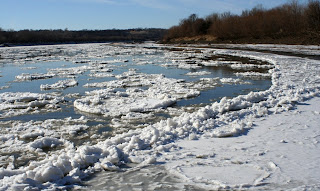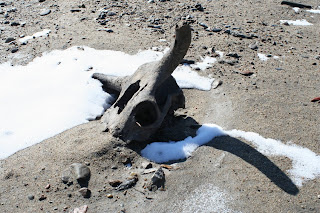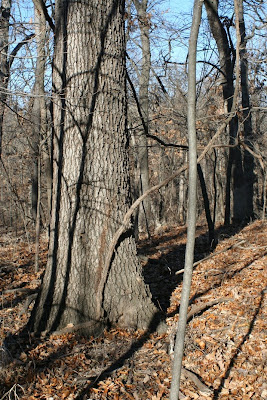 Robert Gaines and Linda Williams, two of our city's most talented "nature-photographers," have been kind enough to share their artwork as well as their passions for the outdoors and the camera with anyone who may have expressed interest. Better yet, the Master Naturalists have taken the time and effort to facilitate the process by creating their personalized websites.
Robert Gaines and Linda Williams, two of our city's most talented "nature-photographers," have been kind enough to share their artwork as well as their passions for the outdoors and the camera with anyone who may have expressed interest. Better yet, the Master Naturalists have taken the time and effort to facilitate the process by creating their personalized websites.Though Robert's blog is not yet finished, it already contains a list of links to share some of his excellent websites. His photos and comments tell of his experiences in places like the Flint Hills, the Buffalo River and Big Bend Nat'l Park in Texas. Visit Linda's website for a handful of her nicest galleries or her Blog for all sorts of exciting local bird sightings (Linda had the opportunity to observe a Snowy Owl on Smithville Lake not too long ago!!!)
Please take a moment to check out the works of these outstanding naturalists- you will not be disappointed!
Linda Williams Photography or see HERE for Linda's Exciting blog!
 As for me- I'm locked up in school for now. It was only a couple of weeks ago that I dusted off my Ancient MinoltaSRT. I bought a few rolls of Ilford100 and hit the streets with a 35mm camera for the first time in almost two years!
As for me- I'm locked up in school for now. It was only a couple of weeks ago that I dusted off my Ancient MinoltaSRT. I bought a few rolls of Ilford100 and hit the streets with a 35mm camera for the first time in almost two years!A long evening walk downtown and 24 exposures later, I found the antique to be very worthy of my hobby! Maybe it is that it is different or that I just have to be creative with the limited geometric subject matter- Shooting in the city and on campus is a bit more difficult than finding exciting photographs in the woods. I think I enjoy the old thing more than the digital camera; though it does cost about 50 cents per photo to have them developed- Almost 90 cents if you want small prints!
( I seem to have developed the nasty habit of disregarding the number of digital photos I take..)
Taking a photo with the heavy metal box, however, is a long, complex process of evaluations and decisions compared to the Point-Click-Pray method I shoot too many of the digital photographs with. Manual Apertures and Shutter Speeds must be quickly determined and manipulated while focus is had for an ever-changing world of fascinating subjects....Perhaps it is my romantic side coming out, or simply an intense appreciation for a dying tradition and the end of the era of honest photography. These photographs require effort and artistry and are so much more valuable when complete. I'd say its a bit like digging crystals; A quality stone which is bought is worthless compared to one that you put so much work into retrieving- like a special relationship is made with the thing by addressing it on such a personal level.
Anyway..
I cant wait to share photo's of Maryville with you! ...I am working on my second roll of film on this cold little town and the Missouri Northwest Campus, but there is nobody within ~100 miles who is able to develop the film. Lots of exciting spots around, though a very noticeable lack of public wild areas. - I'll get photos up soon! Enjoy!



 In many places the ice was solid all of the way down- the rocks and mud at the bottom of the slowest channels were made clearly visible by the ice.
In many places the ice was solid all of the way down- the rocks and mud at the bottom of the slowest channels were made clearly visible by the ice. 

 The same thing happens to the ice that remains attached to the shore- it is ground and polished into shapes that accommodate the flow of the water and the excess ice is piled on the waterline. It is very cool to watch- the process is
The same thing happens to the ice that remains attached to the shore- it is ground and polished into shapes that accommodate the flow of the water and the excess ice is piled on the waterline. It is very cool to watch- the process is  We found some cool stuff, but for the first part of our trip, most of the agates and fossils were frozen to the ground. Mom found a very cool Bison tooth- fossilized and turned blue by time and polished by the river. I got the remains of the skull- it is busted up, but still very cool-looking!
We found some cool stuff, but for the first part of our trip, most of the agates and fossils were frozen to the ground. Mom found a very cool Bison tooth- fossilized and turned blue by time and polished by the river. I got the remains of the skull- it is busted up, but still very cool-looking! 






 My Super-secret sandstone fossil spot on a
My Super-secret sandstone fossil spot on a 
 My favorite was a small fern's. It is not as defined as many that I discovered, but has a very pleasant, natural shape/curve. The
My favorite was a small fern's. It is not as defined as many that I discovered, but has a very pleasant, natural shape/curve. The 



 A quick departure from beneath the town of
A quick departure from beneath the town of 
 I stopped at an unusually bare sandbar and stirred up some invisible geese. The Canada's are
I stopped at an unusually bare sandbar and stirred up some invisible geese. The Canada's are 




 With the beautiful clouds soon came an intruding swell of grey cover. It started out as a long series of dramatic bands and grew into a boring blanket for sunset (
With the beautiful clouds soon came an intruding swell of grey cover. It started out as a long series of dramatic bands and grew into a boring blanket for sunset (

 The sign post on the first glade is down. Its stood for like 10 years? and numerous fires, though the burns have taken a toll on the 4x4 that displays the three signs. Ive got dibs on the
The sign post on the first glade is down. Its stood for like 10 years? and numerous fires, though the burns have taken a toll on the 4x4 that displays the three signs. Ive got dibs on the 


 Minor Park, but only for a short walk. the parking area and trails were unusually busy- lots of joggers. The trail is very rough- horse tracks have turned the mud into a hard, dried trail much
Minor Park, but only for a short walk. the parking area and trails were unusually busy- lots of joggers. The trail is very rough- horse tracks have turned the mud into a hard, dried trail much

 What a beautiful day! Even the bugs thought so; this ladybug enjoyed our 50+degrees at the fireman's memorial where I stopped for a bit of fossil hunting. He
What a beautiful day! Even the bugs thought so; this ladybug enjoyed our 50+degrees at the fireman's memorial where I stopped for a bit of fossil hunting. He 
 I moved onto the next bench after an hour or so, where there were many handfuls of larger, clean-looking
I moved onto the next bench after an hour or so, where there were many handfuls of larger, clean-looking 
 ABOVE are more of the common shells from the lower levels of the memorial. This beautiful trio has been only partially
ABOVE are more of the common shells from the lower levels of the memorial. This beautiful trio has been only partially 


 At least my favorite tree is still there. Its been forever since I walked through the park- enough time for a landscaping company, hired by the city to make the park handicap-accessible, to rip a web of long, wide trails from the ground. The trails are shaped and stripped bare of
At least my favorite tree is still there. Its been forever since I walked through the park- enough time for a landscaping company, hired by the city to make the park handicap-accessible, to rip a web of long, wide trails from the ground. The trails are shaped and stripped bare of  Even nature has done it's part! Last week's severe storms have left the grass in huge mats- it all lays on the ground now. Trees have shed many branches and the older, dead ones have fallen.
Even nature has done it's part! Last week's severe storms have left the grass in huge mats- it all lays on the ground now. Trees have shed many branches and the older, dead ones have fallen.